Outdoor Housing & Keeping
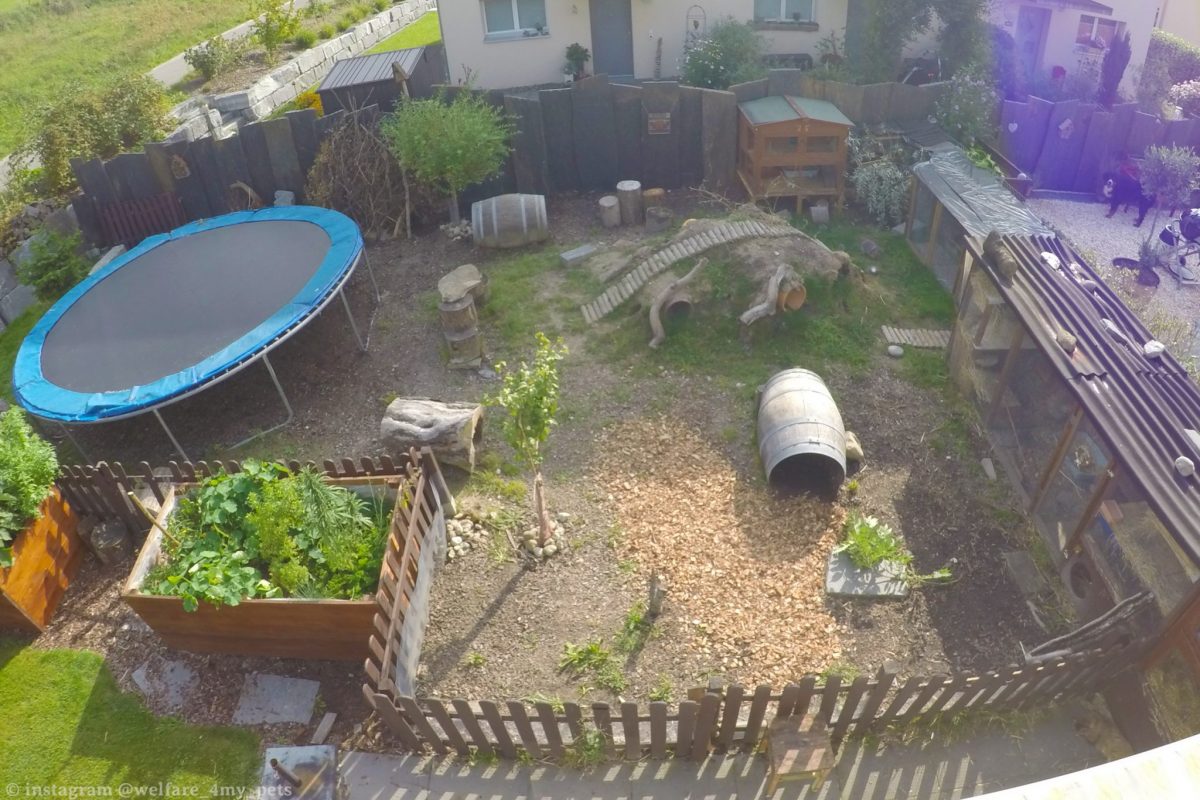
Keeping and housing rabbits outdoors is the most appropriate way to keep rabbits.
However, outdoor keeping does not simply mean leaving your rabbit outside to fend for itself. There are many things that must be considered to ensure your rabbit’s health and happiness outside of your home.
Seasons
• Only change from inside keeping to outside during Spring or Summer
• Ensure your rabbit’s coat and fur is kept in good condition
• Pay particular attention to the Rex breed
In most regions of the world rabbits can be kept outside year round. Changing from indoor keeping to outdoor keeping can only be made during Spring/Summer, when the temperature overnight is consistently over 10 degrees celsius. This is the only way rabbits are able to adapt in Autumn to the cooler temperatures by building up a winter coat. If you have long haired bunnies, you must ensure that knots do not build up. The fur of some long haired bunnies is unsuitable for outdoor keeping because it mats together. This type of fur must be taken care of regularly and trimmed which makes it too cold for the bunny to be kept outside in Winter.
Another breed which one must pay close attention to is the Rex rabbit. In this breed the fur on the fore legs and hind legs is very short and can also develop wounds if the ground is not suitable. Therefore you should regularly check the fore and hind legs and feet of all your rabbits (not only Rex rabbits) and if necessary change the flooring.
Floor Space Requirement
• Allow a generous amount of space – 3m² per rabbit and for every additional rabbit 2m²
• More space allows rabbits to move to keep warm
 Due to the animals being kept 24/7 in the outdoor enclosure and most of the time not having an additional run, the space should be measured generously. The space requirements for the first three rabbits is 3m² per rabbit and for every additional rabbit 2m². These requirements should be adhered to because in Winter, lots of space is especially important, so as to ensure they have the freedom of movement to keep themselves warm. If you have an insufficiently sized (too small) enclosure the bunnies can freeze or freeze to death despite having a Winter coat.
Due to the animals being kept 24/7 in the outdoor enclosure and most of the time not having an additional run, the space should be measured generously. The space requirements for the first three rabbits is 3m² per rabbit and for every additional rabbit 2m². These requirements should be adhered to because in Winter, lots of space is especially important, so as to ensure they have the freedom of movement to keep themselves warm. If you have an insufficiently sized (too small) enclosure the bunnies can freeze or freeze to death despite having a Winter coat.
Site Selection
• Never in direct sunlight – should have shaded and sun exposed areas
• Wind and weather proof
It is very important that the enclosure is not in blaring sunlight. During high temperatures rabbits can develop heat stroke. The ideal location features both shaded and sun exposed areas which grant the rabbit the ability to choose. You should choose a wind and weather proof location or ensure the enclosure has protected corners eg. two sides of the enclosure being build out of plexiglass, fence screening or similar.
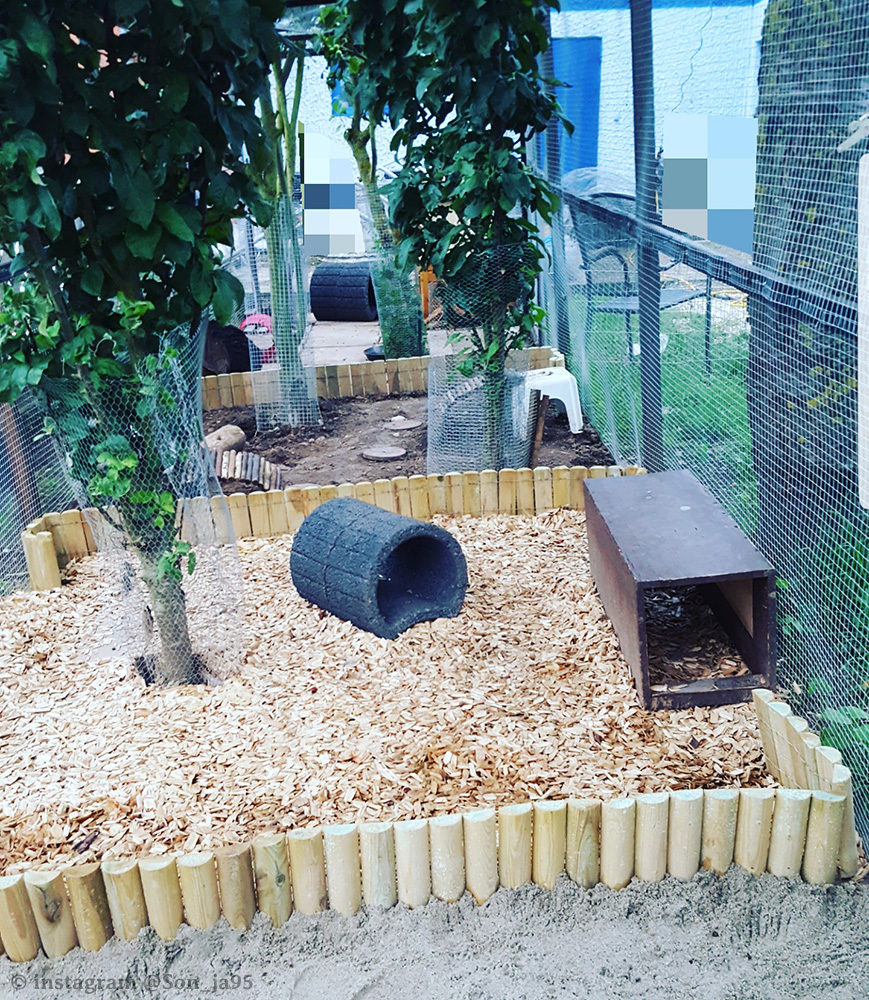
Safeguarding the Enclosure
• Protect rabbits from natural predators – require a secure, gapless enclosure
• Secure from all sides, above and underneath
It is very important to safeguard the enclosure due to natural predators (rats, foxes, weasels, cats, dogs and birds of prey). For this reason the enclosure needs to be gapless and secure from top to underneath and secure from all sides. Any wire must not be coated in plastic, as this can be eaten by the rabbits (poisonous), subsequently exposing the metal to the elements and rusting causing breakage. The enclosure needs to be secured by aviary wire from the roof or be a stable roof constructed from wood. It is often recommended to just put a protective net over the enclosure, however this net does not provide any protection from cats or other predators and is therefore not enough.
Flooring in the Outdoor Enclosure
• Essential – protect rabbits from predators from below
• Many different ways to secure the flooring – choice depends on owner
Safeguarding the flooring of the enclosure is essential. Rabbits love to dig and therefore it must be guaranteed that they cannot dig themselves out of the enclosure or that predators cannot dig themselves into the enclosure. To secure the floor, first the ground must be excavated 30-50cm deep, so that rabbits are granted to ability to dig tunnels.
There are therefore different possibilities:
Pavers & Retaining Wall Stones
You can lay these as a flooring and at the edges of the excavated area. Ensure that the stones are heavy enough and cannot be moved by the rabbits or predators.
Foundation
You can lay a concrete foundation on both the bottom of the excavated area and at the sides. Then you lay wire inside the concrete to connect the flooring with the sides.
Aviary Wire
Can be placed on the sides and the flooring of the enclosure. It is important that it is well connected, with no gaps or spaces, preventing rabbits from escaping or predators from entering.
Once the ground has been excavated and the aviary wire placed, soil can be then placed back into the area to fill the area. (Link to mother ground coming soon)
Normal flower soil is not suitable as it often has fertilizer inside which can be toxic for rabbits. Bark mulch as bedding may look nice however it is absolutely unsuitable due of the different types of wood it contains which may also be toxic. The wood inside this is often also treated with pesticides and is susceptible to mould.
An easier method to secure the ground is to lay pavers or retaining wall stones. It must be sure that the stones are very heavy, with no gaps. This prevents the rabbits from being able to dig themselves under the stones or predators digging themselves over. This method is also easier for the owner when being built as well as when it is to be cleaned. This means that the rabbits cannot dig any more. So you must consider the pros and cons of each method of securing the ground.
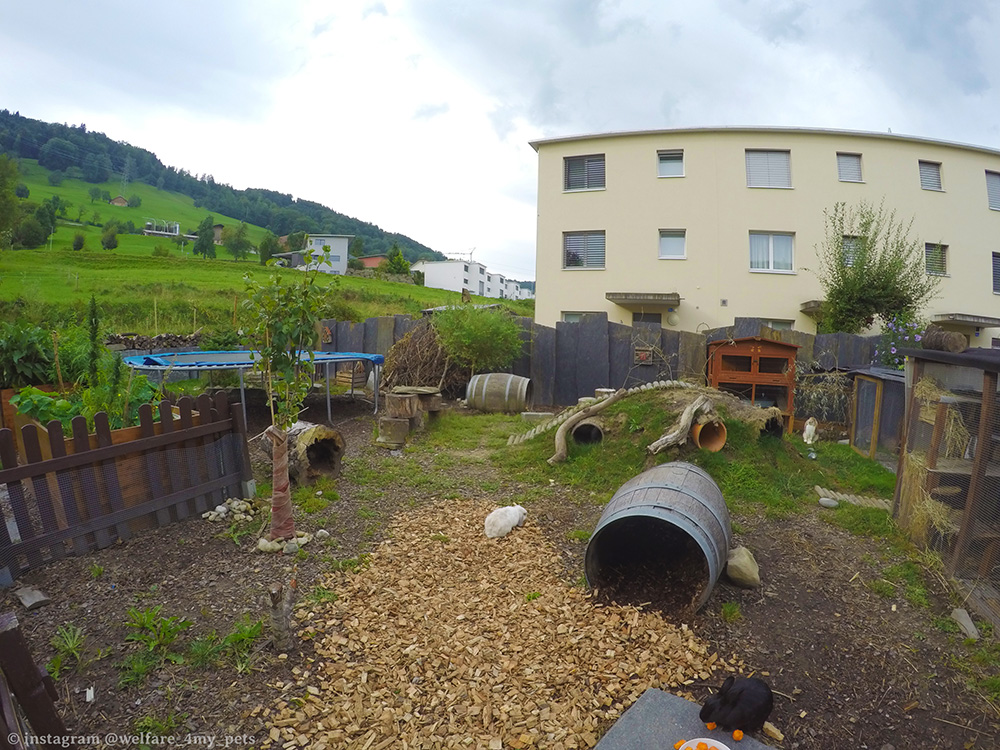
Decorating the Outside Enclosure
• Weather protected hut – can be entered any time – lined with bedding and hay – able to fit all rabbits that live in the enclosure
• Keep decorations varied and interesting – prevents boredom
The main priority to consider is a large wind and weather secured, protective hut where the rabbits can enter at any time. The hut should be ready with bedding, eg straw (very important in winter) and hay. It should also be big enough for all animals that live in the enclosure. In Summer it is very important to have a shaded area and in Winter a place where the rabbits are protected from the cold. The decorations in the enclosure should be varied and interesting, so that there is no boredom. Suitable items include cork tunnels, tree stumps, tunnels, different floor levels are also likely accepted (these should not be higher than 50cms and must be secured so that they cannot injure themselves when then jump up and down from them). If you have secured the flooring with pavers, you can also include a sand pit for your rabbits to dig.
Additional Run
• Extra area but only under supervision
• Make sure it is rabbit safe – no poison plants or dangers/risks
To provide some variety, you can offer the rabbits an extra, secured area in the garden, as long as it is only under constant supervision, has a secured fence, all growing plants in the area are non toxic and all potential risks and dangers (eg. garden ponds) are secured and made safe. Rabbits love the possibility of exploring the garden. Alternatively you can divide the area of the garden with enclosure elements. These should be at least 80cms or 1m high. In every case you must watch them constantly. The ideal additional run is one that allows the rabbits to choose free if they want to use the run or to remain in the enclosure.
Cleaning of the Outside Enclosure
• Very important – regularly clean the enclosure – uncleaned enclosures are dangerous
• Summer high risk fly eggs & Winter high risk freezing
• Clean regularly soiled hay and bedding and wash old urine and toilets
Even an outside enclosure needs to be cleaned. Often the cleaning of the outside enclosure will not be done as often as an inside enclosure. This is grossly negligent. With outside keeping regular cleaning is especially important. In the Winter, urine freezes and the animals are sitting on their toilet, therefore on an iceblock. In Summer the risk of fly eggs is very high. Dirty rabbit toilets, enclosures or corners where the rabbits urinate attracts flies or other pests. Of course you can reduce the fly danger with a fly screen or hygienic, non toxic chemicals. This will however not replace regular cleaning. Clean the enclosure, toilet and the pee corners regularly with water. The enclosure floor, regardless if soil or rock, must be regularly swept, hacked and depending on the flooring type, cleaned with water. When soil is too heavily contaminated or dirtied it has to be changed or replaced. This is only occasional, depending on the level of contamination.
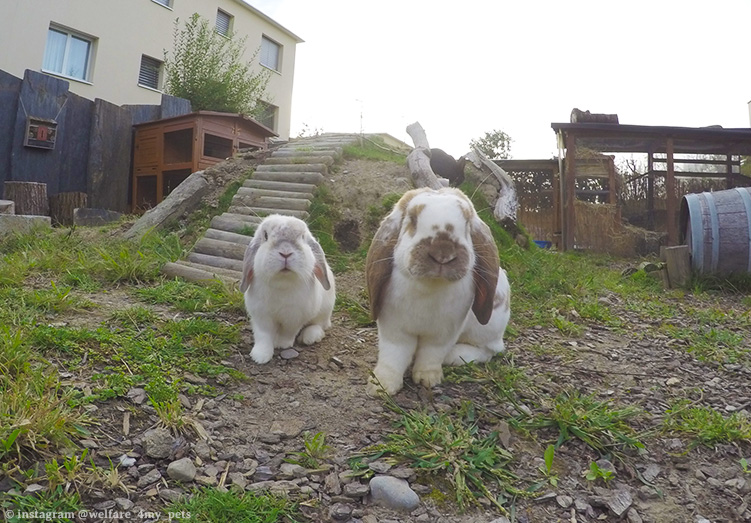 Regular Checks
Regular Checks
• Conduct regular health checks
With outside keeping and enclosures, you do not have the ability to watch your rabbits 24/7. Often the enclosure is far away from the own house. Due to this, thorough checking of the rabbits is necessary. Check your rabbits regularly, also from underneath, to ensure you do not overlook any illnesses or injuries.
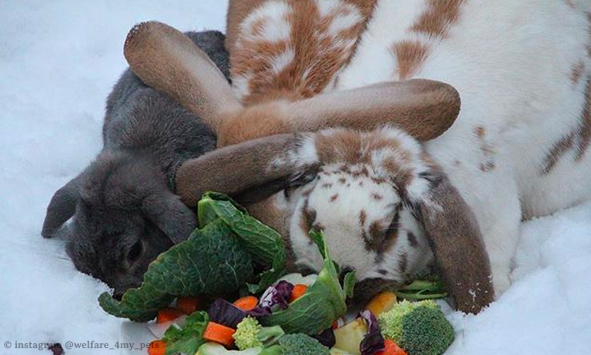
Outside Keeping in Winter
• Change water regularly as it freezes – several times daily
• Freezing can be delayed using tricks
• Ensure fresh food scraps are always removed
• Rabbits are better suited to the cold
• Be aware of Teddy, Angora and Rex breeds – they require special care in Winter due to their coats
Drinking water very often freezes in Winter. You cannot prevent this. However because of this, water needs to be changed regularly, also be sure to check the water bowls. This should be done several times daily. There are also other tricks you can use to delay the water freezing, but you cannot prevent it. One way to delay the freezing is to put a table tennis ball into the bowl. Due to the constant movement, the water freezes slower. You can also use a microwavable heat pillow (Snuggle Safe) under the bowl. This also will slow the process. But also the heat pillow needs to be checked regularly and reheated.
When giving fresh food you must ensure that there are no food scraps left to freeze. Frozen food can have very bad consequences if eaten. Therefore scraps must be removed from the enclosure immediately. Do not worry or question if the rabbits don’t go back in their protective hut when there is snow and ice. Remember that, in general, rabbits are better suited to colder temperatures than hotter temperatures. As long as the rabbits have free access to a thick with straw, insulated hiding place and do not seem apathetic, you need not have to worry.
You have to be careful with long haired rabbits, like Teddys and Angoras, as they have very little under wool, so they become wet to the skin and can easily become sick when it is cold and wet weather. If you want to keep these animals outside, you must ensure that the enclosure has a solid roof and no rain or snow can get inside, therefore ensuring that they do not get wet. This makes sure that the long fur doesn’t freeze when there is frost. Be aware that if you have a Rex rabbit, their under wool and their overcoat is much shorter than other breeds (just 17-20mm). Their under wool is also much thinner which makes it very difficult in Winter to keep their body warm. Their fur also stands up, perpendicular to the skin. Due to this, wind and weather can easily allow hypothermia to develop. These Rex Rabbits can also build up enough of a winter coat if they are early enough in the year (find something more specific) kept outside so they can adapt to the outside conditions prior to winter commencing. Make sure you observe your animals, regardless of breed, throughout winter when keeping in an outside enclosure.
Outside Keeping in Summer
• Heat stroke and exposure is very dangerous
• Enclosure should provide shaded areas to cool
• Feed more watery foods and check water bowls more often
The heat in Summer is very hard for most animals. Animals become floppy, tired and are more likely to stay in cooler areas inside the enclosure. Therefore shaded places for the enclosure or at least shaded areas are very important. You can provide a bit of cooling by laying cold tiles or with bottles filled with cold water. Some animals really enjoy this and others ignore it. It is important they have the opportunity to cool down. On hot days, feed more watery fresh food, eg cucumber, salads, lettuce. The water bowls must be checked regularly because some animals drink more at high temperatures than normal. Another cooling effect can be hanging up wet towels or putting them on the floor.
Back to Housing
